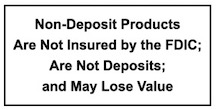
Fraudsters move fast when they successfully convince a victim to wire money. When stolen funds arrive in a fraudster’s bank account, they quickly engage a network of money launderers who withdraw the funds in cash, transfer them to other accounts, and/or convert them to cryptocurrency.
Wire transfers are intended to be a final and irrevocable method of payment. While FSB may attempt to request a recall of the wire transfer, it’s important to note that this is not always possible. The receiving bank may be unable to reverse the transaction, especially if the funds have already been moved or withdrawn.
To increase the chances of recovering your funds and aid in the investigation, take the following steps immediately:
File a complaint with the FBI’s Internet Crime Complaint Center (IC3).
Provide detailed information about the transaction and the scam, including any phishing emails, links, text messages, or other communications you received. The IC3 will give you a Complaint Number, and in some cases, they may be able to freeze the funds.
Contact your local FBI field office.
Share your IC3 Complaint Number and report the details of the crime to the agent handling financial or cybercrime cases. You can find your local FBI field office at this link.
File a police report with local authorities.
Provide all relevant details about the fraudulent activity. Be sure to save the incident or report number and exchange contact information for future communication.
Share documentation with FSB.
Provide FSB with copies of any documentation related to the fraudulent activity. This includes emails (with visible email addresses), text messages (showing phone numbers), and any other information you provided to law enforcement. These details are vital for the bank’s review process.
By acting quickly and following these steps, you can help law enforcement and FSB in addressing the fraud and mitigating further risks.

Awareness and Prevention – Understanding Wire Transfer Fraud
While digital transactions offer numerous advantages, they also present vulnerabilities that entice criminals to engage in elaborate fraud schemes. Wire transfer fraud happens when offenders manipulate or reroute legitimate wire transfers for unlawful financial benefits. This article explores various types of wire transfer fraud, detection techniques and prevention strategies.
Prevalence of Wire Transfer Fraud
Wire transfer fraud has seen a notable increase in recent years:
- In 2023, 80% of organizations reported being targets of payment fraud, marking a 15% increase from the previous year. Wire transfers were among the top three payment methods targeted.
- The Federal Trade Commission (FTC) reported that consumers lost over $10 billion to fraud in 2023, with wire transfers being a significant contributor.
Common Wire Transfer Fraud Schemes
Business Email Compromise (BEC)
Fraudsters exploit businesses by impersonating executives or employees.
Here’s how it works:
- Hacking or Spoofing Emails: The scammer gains access to an employee’s email or creates a lookalike email address that appears legitimate.
- Targeting Financial Departments: They send instructions to accounting or payroll teams to wire money to a fraudulent account.
- Social Engineering: Often, they research the company and use convincing language, referencing specific projects or invoices to appear authentic
Example Scenario: A finance manager receives an urgent email from their CEO (from a spoofed address), requesting a wire transfer for a “confidential acquisition” and emphasizing discretion.
Real Estate Scams
Criminals target buyers, sellers, or real estate professionals involved in transactions.
Here’s how it works:
- Intercepting Communications: Hackers monitor emails between real estate agents, buyers, or escrow companies.
- Fake Wiring Instructions: Just before closing, fraudsters send updated wiring instructions to redirect funds to their accounts.
- Common Targets: First-time homebuyers or those unfamiliar with wire transfers may fall victim more easily.
Example Scenario: A buyer receives a seemingly legitimate email from their escrow company with “urgent updated instructions” to wire closing costs, only to later discover it was a fraud.
Romance Scams
Scammers prey on individuals seeking companionship, often through dating apps or social media.
Here’s how it works:
- Building Trust: Over weeks or months, the scammer establishes an emotional connection, sharing personal details to appear genuine.
- Fabricated Emergencies: They claim to need financial help for a medical crisis, legal trouble, or travel expenses to visit the victim.
- Red Flags: Requests for secrecy or an unwillingness to meet in person.
Example Scenario: A victim believes they’re helping their online partner pay for emergency surgery overseas, only to learn the person never existed.
Recognizing Warning Signs
Unexpected Requests
- Be wary of any email, phone call, or message that asks you to wire money when it wasn’t anticipated. This is especially true if the request comes from someone claiming to be a known contact but is slightly “off,” such as using unfamiliar wording or requesting funds for unverified reasons.
Example: A supplier suddenly requests payment via wire transfer, but they usually accept checks or another method.
Urgency and Pressure
- Fraudsters create a sense of urgency to bypass your usual checks. They might claim dire consequences if the wire isn’t sent immediately.
Example: A message stating, “Funds must be wired today, or the deal will fall through,” can indicate fraud. Legitimate transactions rarely have such unreasonably short deadlines.
Changes in Payment Instructions
- Fraudsters may exploit last-minute changes in wiring details to trick you. Always verify changes directly with the other party, using a trusted contact method.
Example: Receiving an email saying, “Our bank details have changed; please use this account instead,” should raise immediate suspicion.
Additional Tip: Always double-check wiring details with a trusted party by phone, using a number you know is correct—not one provided in the email. If something seems unusual or rushed, take a step back to verify.
Preventative Measures
Safeguard Yourself Against Wire Transfer Fraud
As a general cybersecurity rule, avoid sharing sensitive or personal information online, such as your Social Security number, credit card details, or date of birth, as these can be used for identity theft. Additionally, there are targeted steps you can take to further protect yourself against fraud.
- Verify Identities: Confirm the legitimacy of the recipient through direct communication before initiating a transfer.
- Don’t click on any links or attachments that you are not familiar with. These links can come by email or phone in the form of texts and clicking on them can expose personal and financial information and email contacts.
- Fraudsters may also send a phishing email posing as a business you’re already associated with, such as your energy provider or bank. Before clicking on any links within the email, double-check their email address to ensure it’s correct, or go straight to the company website via your browser rather than through the email link.
- Be Skeptical of Unsolicited Communications: Approach unexpected emails or calls requesting funds with caution.
- Establish Strong Security Protocols: Implement multi-factor authentication and regularly update passwords to protect accounts.
- Where possible, involve more than one person in wire transfer and bill payment transactions.
- Educate and Train: Make sure that co-workers and family members are informed about the risks and indicators of wire transfer fraud.

Understanding Spoofed Emails: How to Recognize and Protect Yourself
What Are Spoofed Emails?
A spoofed email is a message that appears to come from a trusted source, such as a colleague, financial institution, or company, but is actually sent by a cybercriminal. The goal is to deceive you into sharing sensitive information, clicking malicious links, or completing fraudulent transactions.
How to Recognize a Spoofed Email
- Check the Sender’s Email Address:
- What to Look For: The sender’s address may look similar to a legitimate one but with slight alterations, such as “support@bank-secure.com” instead of “support@bank.com.”
- Tip: Hover over the email address to reveal the true sender.
- Examine the Subject Line and Tone:
- What to Look For: Fraudsters often use urgent or alarming language like “Immediate Action Required” or “Your Account Will Be Locked.”
- Tip: Legitimate organizations rarely demand immediate action without prior notice.
- Look for Poor Grammar or Spelling Errors:
- What to Look For: Professional organizations typically proofread their emails, so errors may indicate fraud.
- Tip: Be skeptical if the email feels unpolished or unprofessional.
- Inspect Links Before Clicking:
- What to Look For: Links in spoofed emails often lead to fake websites designed to steal your information.
- Tip: Hover over any links to check the URL, and avoid clicking if it doesn’t match the official site.
- Unexpected Attachments:
- What to Look For: Attachments can contain malware. Be cautious with files like .exe or .zip formats, especially if unexpected.
- Tip: Confirm the sender’s identity before opening any attachment.
How to Protect Yourself
- Verify Requests: If you receive an email asking for personal or financial information, contact the sender directly using a trusted phone number or email—not the one provided in the message.
- Enable Multi-Factor Authentication (MFA): Use MFA for your email accounts to make unauthorized access more difficult.
- Update Software Regularly: Ensure your email client, antivirus, and operating system are up to date to guard against vulnerabilities.
- Use a Spam Filter: Many email services have advanced filters to catch potentially malicious emails before they reach your inbox.
- Educate Yourself and Others: Familiarize yourself and your team with the tactics used in email fraud and encourage skepticism of unsolicited messages.
By staying vigilant and taking proactive steps, you can significantly reduce the risk of falling victim to spoofed emails and protect your personal information.

